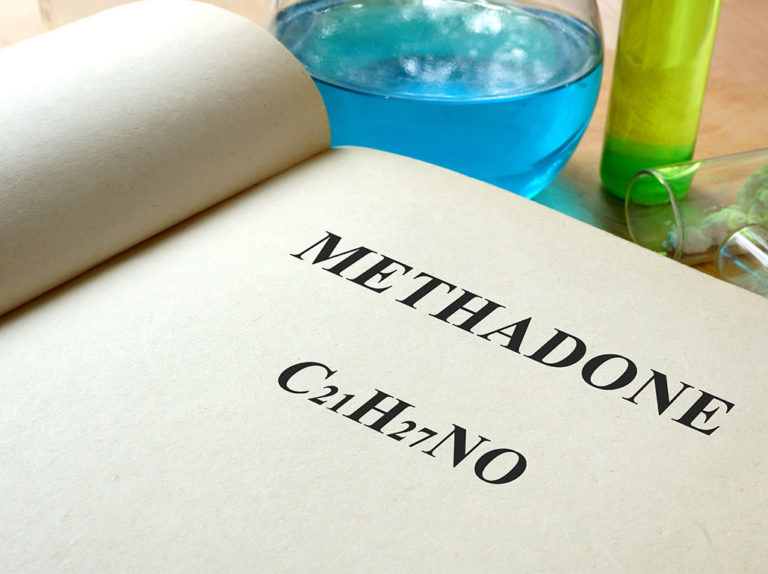Methadone is a synthetic, narcotic analgesic (pain reliever). Often used by and associated with the treatment of heroin addicts it is also used for other medical purposes such as pain relief. The drug shares many of the same effects and characteristics of morphine and acts in similar ways to it and other narcotic medications. However, with methadone the gradual and mild onset of action prevents the user from getting high and experiencing euphoric effects.
Doses used in heroin treatment vary based on a person’s body weight and opiate tolerance; but proper dosage is measured and determined by a patients decline in opiate cravings. Despite its use in the treatment community, there are addicts who use methadone as their primary drug of choice. Supplies of the drug for these users are illegal and are diverted from legitimate methadone programs by enrolled methadone patients. The drug is currently a Schedule II and is available in oral solutions, tablets, and injectable forms. And although there is no one manufacturer responsible for producing methadone, the active ingredient is always the same: methadone hydrochloride. Still, methadone is frequently encountered on the illicit market and has been associated with a growing number of overdose deaths.,
History
The chemical structure of methadone was first produced in the 1930’s as a team of German scientists was searching for a pain-killing drug (analgesic) that would not be as addictive as morphine. In 1937, two scientists (Max Bockmhl and Gustav Ehrhart) uncovered a synthetic substance that they called Hoechst 10820 or polamidon. Years later during World War II another team of German scientists expanded on earlier research and began synthesizing the substance as a result of short supplies of morphine and other analgesics. By the end of the war, the United States had obtained the rights to the drug from war requisitions and later coined the name methadone. Soon after in 1947 methadone was introduced into the United States to be used as a pain reliever for a variety of conditions, but eventually uncovered its usefulness in treating narcotic addictions. Until the 1960’s, little scientific advancement was made with regard to methadone. But with a resurgence of heroin addiction, researchers began to search for a substance that could reduce or eliminate drug craving and withdrawal signs and symptoms. The idea behind this research was that methadone could be used to manage or maintain heroin addiction. In 1964, the effectiveness and usefulness of using methadone maintenance (i.e., using it as a substitute narcotic to prevent withdrawal) was realized. In the spring of 1971, methadone treatment for opiate dependence began to expand. That year the Federal Government developed regulations governing the use of methadone in the treatment of heroin addiction; final regulations were published in December 1972. Few advancements were made until 2001 when regulations over methadone were modified to allow physicians and other health care professionals to provide methadone more effectively and consistently.
Physical Effects
Though methadone is primarily used for treating narcotics addiction, users can still experience negative physical effects. Careful monitoring and a close relationship between a doctor and the patient are essential to its proper use. Reinforcing effects of methadone are limited, as the drug is designed to block the pleasurable effects of opiates, but only when administered in the correct dosage(s). Some of the physical and side effects of methadone are:
Short-term
- Restlessness
- Vomiting
- Nausea
- Slowed breathing
- Itchy skin
- Pupil contraction
- Severe sweating
- Constipation
- Sexual Dysfunction
- Death
Long-term
- Lung and respiration problems
Effects on women
- Menstrual cycle changes or lapse in cycles
- Pregnancy complications if users reduce dosage levels during pregnancy
Methods of Use
Methadone is dispensed primarily in oral forms, including tablets, powder, and liquid for the treatment of narcotics addiction. Single doses, which should not exceed 80 – 100 milligrams daily, can last anywhere from 24 to 36 hours depending on user characteristics (e.g., age, weight, level of addiction, and tolerance); the long-acting nature of the drug is a distinct advantage since it requires less frequent administration, limiting potential harmful effects.13 Tablet forms of the drug, sometimes called diskettes, contain approximately 40 milligrams of methadone and are often dissolved in water and ingested orally. There is also a white crystalline powder form available that is dissolved in water and swallowed. Finally, liquid is sometimes used in treatment clinics; with this method dosages of methadone can be tightly controlled and adjusted to as small as one milligram, this allows patients to receive just the right amount of methadone needed to curb their withdrawal symptoms.14 Illicit methadone is sometimes administered through injection (injection is not a valid route of administration in treatment) directly into the bloodstream. This form subjects users to increased risks of a variety of diseases, including HIV/AIDS.
Slang Terms for Methadone
- Dollies
- Dolls
- Mud
- Phyamps
- Red Rock
- Tootsie Roll,
- Amidone
- Fizzies
- Balloons
- Breaze
- Burdock
- Buzz Bomb
- Cartridges
- Jungle Juice
- Junk
Paraphernalia
Cracker – device used for opening methadone cartridges
Alternatives to Methadone
Aside from methadone, there are currently at least two alternative options for the treatment of opioid dependence: Bupernorphine and LAAM. But it is still important to remember that outside of a doctor’s care these drugs can be equally as addictive as methadone, resulting in dependence, tolerance, and withdrawal.
Bupernorphine
Bupernorphine is a potent (30-50 times greater than morphine) semi-synthetic narcotic substance that has recently been approved (after 12 years of extensive research) to help treat heroin and opioid dependency.26 First developed in the late 1970’s, Bupernorphine is currently available in the United States as an injectable Schedule V narcotic analgesic (Buprenex) for human and veterinary use 27 (tablet forms are also available). Unlike the other treatment drugs, Bupernorphine produces far less respiratory depression and is thought to be safer in the event of an overdose. In addition, it does not produce significant levels of physical dependence or discomforting withdrawal symptoms; so discontinued use is easier than methadone.
LAAM
In 1994 the FDA approved L-alpha-acetyl-methadol (LAAM) as a Schedule II drug for use in treatment of addiction.28 LAAM may be used instead of methadone because it has longer lasting effects, and instead of daily visits to treatment, addicts may only need to take the drug three times a week. Considered safe and effective, this drug is available primarily in oral forms such as pills and tablets. Like methadone, LAAM does not produce euphoric effects; however, because most patients are not familiar with LAAM, they may be initially more anxious and need more counseling and support when receiving the medication than they would with methadone. In addition to anxiety, users are subjected to a number of side effects such as: abnormal liver functioning, rashes, nausea, and increased blood pressure.
Addiction, Tolerance, Withdrawal, and Dependence
Although methadone is intended to prevent narcotics addiction and dependence along with associated withdrawal symptoms, there is still the possibility of becoming addicted. In fact methadone is an extremely physically addictive drug; however addiction is less likely when under the supervision of a doctor. Tolerance to methadone can also occur with frequent administration, though studies have shown that a user’s tolerance may not increase if prescribed correctly. Withdrawal symptoms occurring from the use of methadone are not as common as they are with heroin; therefore it is possible to maintain an addict on methadone without certain harsh side effects. Psychological and physical dependence can develop with the use of methadone.24 For instance, use of the drug continues a user’s opioid dependency, but frees them from uncontrolled, compulsive, and disruptive behavior associated with heroin addiction.
Methadone Maintenance
First appearing in Canada, methadone maintenance programs in the U.S. are often thought about as one of the most common and effective means for treating heroin addiction; in the late 1970’s they gained considerable acceptance and already had more than 75,000 participants. The term “maintenance” is used in describing these programs because the goal is to “maintain” a narcotics abuser for the purpose of helping him or her avoid the negative and sometimes severe withdrawal symptoms. This type of treatment views addiction as a disease rather than a psychological disorder or character flaw. A number of studies have looked at the effectiveness of methadone programs, and a majority of them have found that methadone can reduce narcotics related deaths, heroin users’ involvement in crime, the spread of AIDS, and also help users gain control of their lives.
Courtesy The University of Maryland
If you need help with methadone or heroin, visit Recovery Guidance for a free and safe resource to find addiction and mental health professionals near you.
Save





















